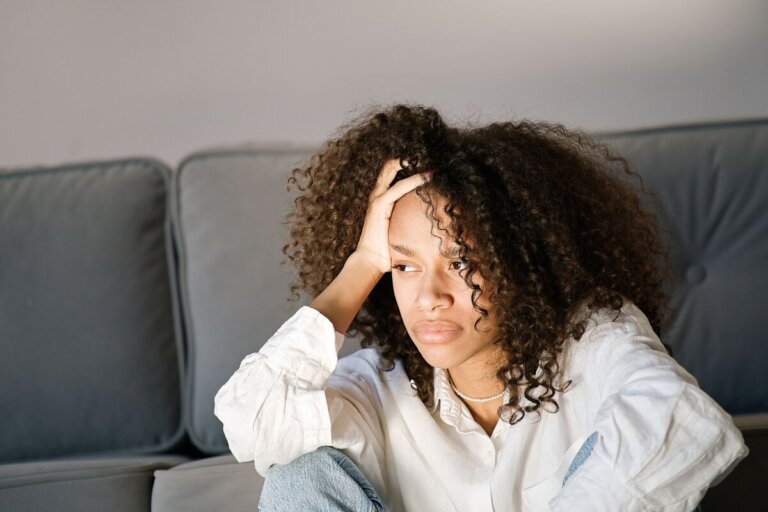The 7 Most Common Complexes in Women


Written and verified by the psychologist Maria Fatima Seppi Vinuales
“Be size zero…Be double size zero…Bleach this. Your skirt is too short. Your shirt is too long…” These are just some of the phrases in “Be a lady, they said,” a poem by Camille Rainville, which she published on her blog and which later became a viral video, as the material addresses and denounces the multiple mandates that weigh on women, leading to common complexes.
All these messages circulate in conversations with friends, in uncomfortable questions from family members about your appearance, and in the media. Because of their insistence and frequency, they end up shaping ideals to be achieved and also frustrations. Here are some of the most common complexes in women.
The 7 most common complexes in women
These are some of the complexes that occur most frequently in women and that represent, in the long run, problems of insecurity and self-esteem:
- Weight. Many women feel self-conscious because they have a few extra pounds or because they are too skinny and without curves.
- Height. Either because they are tall or short. Women of short stature have a great complex, as it has even lent itself to making jokes about it.
- Hair. Women struggle with their hair in a thousand possible ways: they’re not happy with the color, with the fact that it is straight or has curls, with the fact that it is thin, with the gray hair, etc.
- Stretch marks, cellulite, and wrinkles. Everything that is a mark on the skin, can be the origin of a complex or the choice of certain clothing that hides it. There are women who don’t wear shorts or do not go to the pool because they feel self-conscious about their cellulite.
- Age. Society is governed by criteria regarding age, where the young is valued over the old or the antique, which is equated to that which is no longer useful. For this reason, women also make a great effort not to show the passage of time.
- Breasts. Many women complain about the size of their breasts, as they consider them small. Those who are more prominent often suffer because some people comment or joke about them.
- Dark circles under the eyes. Sometimes, the coloring under the eyes becomes violet or darker. Many women suffer because of the way the dark circles under their eyes stand out, hiding behind layers of makeup.
Like this article? We think you may also like to read: Understanding the Impact of Stress on Mental Health: Effective Coping Strategies
Gender issues
It’s worth giving some background context to understand the origin of these physical complexes. In society, a certain type of body is often idealized: the bodies that are considered desirable – and even perfect – are slender, slim, without scars or marks, with a light skin color, straight hair or with easy-to-wear waves (but not tight curls).
In short, all these stereotypes about the hegemonic body dictate how others should be, overlooking body diversity. However, we must be very careful because, many times, what’s defined as beautiful is not healthy, which exposes women to situations that end up damaging their own health.
Among these actions are the following:
Drastic measures to achieve an ideal image
Extreme diets, surgeries, exaggerated exercise, and old practices such as the use of girdles, shapers, or corsets to slim the waist, among others. This is how, at present, the quality of life of many women is affected in an attempt to achieve that ideal. For example, consequences due to malpractice in surgeries, and the rejection of the implants in the body, among others.
Episodes of anxiety
Also, the pressure to have a hegemonic body has a great influence on self-esteem and body acceptance. Women who are unhappy with their body image may be experiencing anxiety, depression, difficulties in relating to others, and eating disorders. For example, in Argentina, according to the Argentine Society of Pediatrics (SAP), one out of every three women has an eating disorder (ED).
Accepting prejudices
It’s not about criticizing those women who like to look and feel good and invest time and money in doing so. The question is to clarify why they do it and how they act inrespect to those who don’t.
In this sense, it isn’t the same for a woman to look after her body because she wants to and chooses to as doing it for the sake of what others will say or for fear of losing her partner. Prejudice may be present on many more occasions than you think.
It’s also incredibly important that women who are concerned about their appearance don’t belittle or look down upon who who aren’t.
You may also like to read this article: Celebrities Quit Social Media to Protect Their Mental Health
The importance of education when it comes to accepting diversity
Although men also suffer (for example, in the case of alopecia), it’s mostly women who suffer from aesthetic violence. For this reason, it’s necessary to educate from an early age about respect for different types of bodies, both in the family, at school, and, especially, in the media. These are largely responsible for creating and disseminating on a large scale certain messages and stereotypes about girls and women.
How can you love and respect your body more and also that of others? Here are some final tips:
- Avoid commenting on other people’s bodies. None – not even those that you consider a compliment or positive, such as, “You look so skinny,’ or “That looks great on you”.
- Never use bodily characteristics to refer to a person: For example, “that skinny woman,” or “the lady with the big eyebrows.”
- Accept that the body and beauty are only physical aspects – they only scratch the surface of all that a person is. By no means do they define him or her, nor do they explain him or her completely. To practice this, start with yourself. What other aspects would you highlight about yourself? What are you most proud of? It’s important to learn to look for and recognize one’s own value in order to build solid self-esteem.
- Learn to recognize beauty in diversity. Look for inspiration in women who accept their bodies as they are.
Remember that it’s about learning to accept more realistic bodies that don’t demand superhuman efforts to be fit or aesthetically pleasing. Everyone has an active role to play in breaking down stereotypes.
All cited sources were thoroughly reviewed by our team to ensure their quality, reliability, currency, and validity. The bibliography of this article was considered reliable and of academic or scientific accuracy.
- Aparicio, E. (2015). Los medios de comunicación en la violencia contra las mujeres: el paradigma de la delgadez. Historia y Comunicacion Social. https://www.researchgate.net/publication
- Espina, A., Ortego, M. A., de Alda, Í. O., Yenes, F., & Alemán, A. (2001). La imagen corporal en los trastornos alimentarios. Psicothema, 13(4), 532-538. https://www.redalyc.org/articulo.oa?id=72713401
- Moscoso Salazar, J. E. (2010). Re-inventando cuerpos: construcción de estereotipos de belleza a partir del” peso ideal” (Master’s thesis, Quito: FLACSO sede Ecuador). https://repositorio.flacsoandes.edu.ec/handle/10469/3759
- Riji, H. M. (2006). Beauty or health? A personal view. Malaysian family physician: the official journal of the Academy of Family Physicians of Malaysia, 1(1), 42. https://www.ncbi.nlm.nih.gov/pmc/articles/PMC4797041/
- Télam. (2021). Una de cada 3 mujeres jóvenes padece trastornos alimenticios. https://www.telam.com.ar/notas/202106/558526-jovenes-padecen-trastornos-alimenticios-incremento-cuarentena.html
- Trastornos de la conducta alimentaria. (2022). Oficina para la Salud de la Mujer. https://espanol.womenshealth.gov/mental-health/mental-health-conditions/eating-disorders
This text is provided for informational purposes only and does not replace consultation with a professional. If in doubt, consult your specialist.








